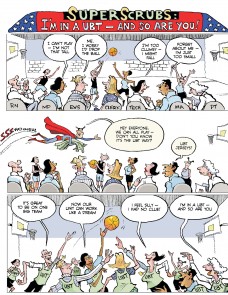Five-Minute Fix Sharpens Team Focus
Deck: Visual boards show team members what they need to know
Wondering how to keep your meetings short and to the point? Stop by Gilroy Medical Offices in Northern California and watch a unit-based team power through its five-minute daily huddle.
On a Tuesday in October, the Family Medicine UBT for Station 1 gathers around a magnetic marker board filled with visual reminders and messages. Medical assistant and SEIU-UHW member Nabi Lopez takes her turn leading team members through the day’s staffing and scheduling assignments, a discussion of where they stand on key clinical goals and upcoming department events.
Exactly five minutes after they gather, a buzzer sounds, and the 10 nurses, physicians, clerks, pharmacists, EVS staff and others head off to start their day.
A new routine
Crisp meetings and high team engagement were not always the norm for the department.
“Prior to using visual boards, our meetings were few and far between,” says SEIU-UHW member Dawn Reyes-Takaki, a medical assistant and member of the original project team. “They were chaotic, filled with complaints and negativity. Staff felt that changes were forced on them with no input.”
Three years ago, a San Jose-based team studied performance improvement techniques in other organizations. One of the ideas that stood out was the use of visual boards. A larger group of managers, workers and improvement advisors agreed on necessary adjustments and a standard format for the boards, and selected Gilroy Medical Offices to test their use.






